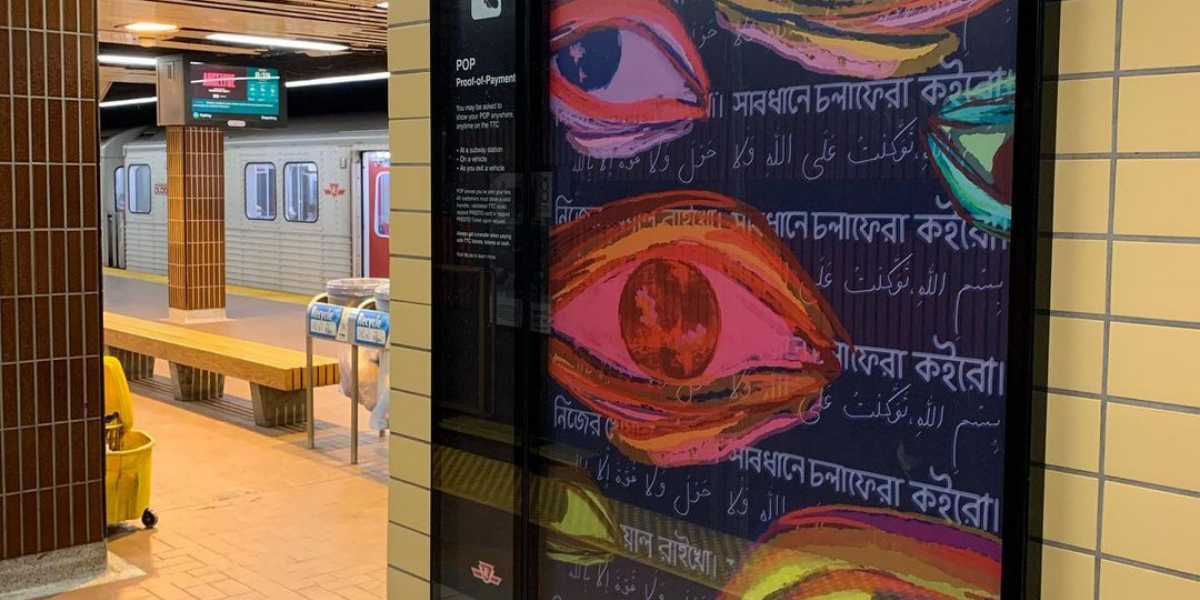সাবধান / SHABDHAN (“careful”) is a collaborative artwork by queer Bangladeshi artists L. Akhter and namrata. Part of the Mayworks Festival, the installation and accompanying poem is displayed at the easternmost Scarborough subway station, central to the homes, workplaces, and lives of South Asian migrant and marginalized people. Spring spoke to the artists to understand the context of the art that explores surveillance faced by Bengali communities.
Can you talk about how your work explores the concept of policing and surveillance in your community?
L: I wrote it specifically from the perspective of the policing that you face as a queer Muslim Bengali person by the state and also from my own community. I tried to express how even in our most intimate moments, we’re not alone. My community and my God is with me and there is a sense of watchfulness that is not loving or caring, but critical and anxious. And it makes us want to hide our identities. When I’m outside, the media and the state play the same role of surveillance.
The texts that are incorporated in the illustration are what we hear from our families and elders when we step outside, where the meaning of care is anxious and associated with the need to be careful. So I wanted to ask the community, why are we surveilling one another? My poem is a larger call to the Bengali Muslim community to ask ourselves what are we doing to the people who are most marginalized in our community when we say “take care of yourselves” but we really just mean “be careful and don’t step out of line”?
n: Yeah, the piece distorts the meaning of care in this way and challenges the self-surveillance within the community. The artwork on the subway plays on a sense of nostalgia because this is what we grew up hearing but when you take a closer look, it encapsulates a disturbing realization that we are marginalizing folks from within a [Bengali] community that already faces marginalization within the fabric of Canadian society.
Your art is on display at Kennedy Station in Scarborough, one of the eastern most subway stations – what is the importance of situating your work in this space/location?
L: When we moved to Canada, we lived in Crescent town first and then moved near Kennedy station—these areas are what represent Scarborough to me. Kennedy station is so central to the working class Bengali community. There are always renovations happening there but nothing changes. The Eglinton line, for example, has been under construction for years and the entire place is just congested. The neighborhood is severely underfunded when it comes to infrastructure and public services, let alone arts and culture. It’s obviously not a coincidence that it is one of the lowest income areas in Scarborough Southwest. This is why I chose Kennedy station. I want my community to see our art and be able to read the text, interact with the message and notice that the eyes are watching. This artwork’s commentary is from within the community, and for the community.
n: Yes, the site specificity of this piece is really important. We put Bengali on the subway, and that’s huge for us. But we are also challenging the community to be introspective on quite a radical plane.
Part of the art work is a poem that talks about marginalization on multiple levels of race, gender, sexual orientation, etc. What role does solidarity play in resisting oppression?
L: As a queer Bengali Muslim you are always navigating intersections of sexuality, race, class and religious identity, and that can be so detrimental to like who we are and the unity that we crave. But throughout the pandemic, I’ve actually found solidarity and support from other queer Muslim youth who have created those spaces for ourselves that I didn’t even think was possible for us. Queer Muslim Network is obviously a big part of how I started feeling very connected to other queer folks. I started volunteering with them and delivering iftar and mutual aid to other queer Muslims. It taught me a lot about how to show up for each other when the state kind of disposes of us and creates violent images of us and uses our own community to paint us in a certain way. There is a misunderstanding that “all Muslims are against queer people,” especially when the lens is of being an outsider talking about the queer Muslim community as opposed to us together talking about it. I feel like we kind of created our own intersections of solidarity against the state that tells us that there’s no coexistence when it comes to queerness and Islam. It’s important to me that people can see that it is possible and we do exist.
Shabdhan/ সাবধান is part of a series of installations curated by Mitra Fakhrashrafi called In Transit that responds to existing and deepening divides in Toronto, especially those shaped by transportation infrastructures with long histories of connecting and fracturing communities.
On Saturday May 21st, join In Transit artists and organizers Jessica Kirk, L. Akhter, and Sarom Rho for day-long activities in Dentonia Park. Connect with L. Akhter and namrata on Instagram @ls.akhter and @nmrtchwdhry
Did you like this article? Help us produce more like it by donating $1, $2, or $5. Donate


